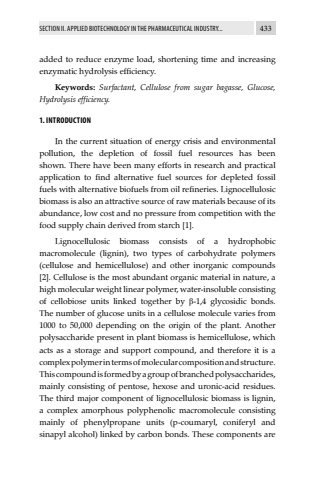Page 429 - Demo
P. 429
SECTION II. APPLIED BIOTECHNOLOGY IN THE PHARMACEUTICAL INDUSTRY... 433added to reduce enzyme load, shortening time and increasing enzymatic hydrolysis efficiency.Keywords: Surfactant, Cellulose from sugar bagasse, Glucose, Hydrolysis efficiency.1. INTRODUCTIONIn the current situation of energy crisis and environmental pollution, the depletion of fossil fuel resources has been shown. There have been many efforts in research and practical application to find alternative fuel sources for depleted fossil fuels with alternative biofuels from oil refineries. Lignocellulosic biomass is also an attractive source of raw materials because of its abundance, low cost and no pressure from competition with the food supply chain derived from starch [1]. Lignocellulosic biomass consists of a hydrophobic macromolecule (lignin), two types of carbohydrate polymers (cellulose and hemicellulose) and other inorganic compounds [2]. Cellulose is the most abundant organic material in nature, a high molecular weight linear polymer, water-insoluble consisting of cellobiose units linked together by %u03b2-1,4 glycosidic bonds. The number of glucose units in a cellulose molecule varies from 1000 to 50,000 depending on the origin of the plant. Another polysaccharide present in plant biomass is hemicellulose, which acts as a storage and support compound, and therefore it is a complex polymer in terms of molecular composition and structure. This compound is formed by a group of branched polysaccharides, mainly consisting of pentose, hexose and uronic-acid residues. The third major component of lignocellulosic biomass is lignin, a complex amorphous polyphenolic macromolecule consisting mainly of phenylpropane units (p-coumaryl, coniferyl and sinapyl alcohol) linked by carbon bonds. These components are


